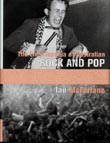|
|

Ian McFarlane Australian ROCK legitimized At last, after decades of waiting, a decent reference book on Australian music! Ian McFarlane's book is obviously a labour of love, and is, for him, a culmination of many years working in music journalism in this country. It is a sprawling text covering a huge range of performers and spanning forty years of Australian rock. How do you assess the quality of a reference work such as this? There are a number of ways that come to mind summed up in the following questions: How does it rate to other texts of its type? Well, as there are no other exhaustive texts of this type around I guess it stands as a clear winner here. Noel McGrath attempted the task in the late seventies (Noel McGrath's Australian Encyclopaedia Of Rock, Outback Press, 1978) and published the occasional update over the next half dozen or so years, but it was, comparatively, of poor quality with very brief entries for the artists he chose for inclusion. McFarlane, of course, has had the luxury of being able to use material from the ensuing 20 years - a period which has seen the Australian music industry flourish spectacularly. Other specific texts on the Australian music scene have suffered from cheap production values and poor research, resulting in thin and unsatisfying publications that have, understandably, sold poorly and have rarely troubled the reprinters before sinking into oblivion. McFarlane's book is one of substance and will become the benchmark from now on. He has made a stand and announced, through this publication, that it is time to take the local industry, and the often exceptional talent working within it, seriously. It succeeds in proving the legitimacy of 'Oz rock' once and for all. How inclusive is its content? McFarlane clearly states his criteria for inclusion at the outset and has as a result left out some notable artists and acts who do not clearly fit into the parameters of the 'rock and pop' genre. This is fair enough. He has also left out a number of New Zealand acts that would normally come under the umbrella definition of 'local'. The 'Australian' in the title is not a collective term for all Australasian acts as is usually the case. This is a shame, I was hoping for entries on The Bats, The Chills and other quality New Zealand acts but looked in vain. McFarlane does however draw the readers' attention to John Dix's text, Stranded In Paradise: New Zealand Rock & Roll 1955 - 1988 (Paradise Publications, 1988), for information on such performers, which goes some way to excusing him for this decision. So that leaves our focus directly on the Oz rock music scene. Mc Farlane has included over 800 entries in this book - and these provide a reasonably exhaustive coverage of the major players of the last four decades. Is there an entry for Chetarca? With books of this type a good test is to think of the most obscure artist you can think of and see if you can find an entry for them. Repeat this process a dozen or so times and see what your strike rate turns out to be. If it is high then the bets are that you have a book put together by an author who has tried to be as thorough and complete as possible. Chetarca, the band, were a non-event really. I have one single 7" record by them that they released in the early seventies. They were a sort of poor quality copy of Emerson, Lake & Palmer if I remember rightly ... Page 118. A reasonably lengthy paragraph detailing lineups and band history and record releases (one single and one album) - and the fascinating news that one member went on to work with John Paul Young's band ("Love Is In The Air") and another became a member of Men At Work! Rabbit's Wedding and The Sea Monsters don't make the cut but Martha's Vineyard, La Femme, The Odolites, The Mad Turks From Istanbul and The Paradise Motel all have substantial entries. McFarlane clearly passes the test. Does the book tell you anything new about well-known artists? Yes it does. McFarlane scores well on this point. In particular, there is a lot of fun to be had reading through the text and working through the incestuous way that personnel changes took place. Australia is a big place, geographically speaking, but it has a reasonably small population and it is therefore easy to play the game 'Six Degrees of Separation' with the artists detailed in this book - you rarely have to go beyond two or three links to relate musicians from any Australian state to others from elsewhere. His detail on Australian independent artists is considerable and is perhaps the book's greatest achievement. His research into artists from the late fifties and early sixties is an important addition to the body of literature on this subject also. All things considered, this book is well worth the money. If you can also get hold of Chis Spencer's Who's Who Of Australian Rock (Five Mile Press, 4th Edition, 1996) then you will have as exhaustive coverage of the topic as you could possibly want. The final recommendation for any reference text comes from the simple statistics on how often you refer to the text after you purchase it. I have had it for four weeks now and it has spent more time off the shelf than on it. It may well prove more indispensable than I first thought! Copyright © 1999 Ken Grady
|
| © 2011 Luna Kafé |